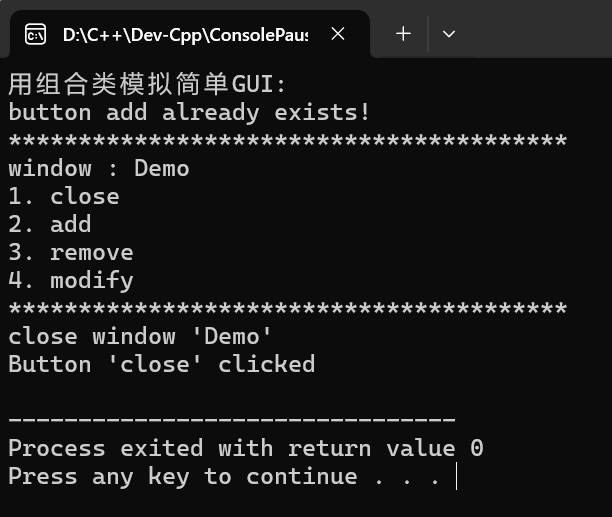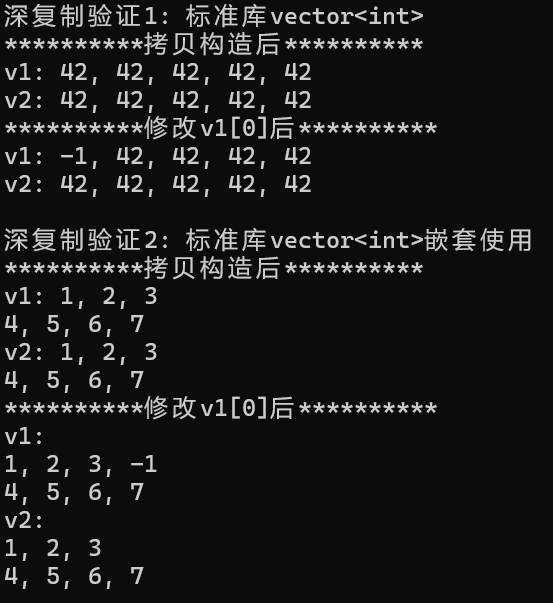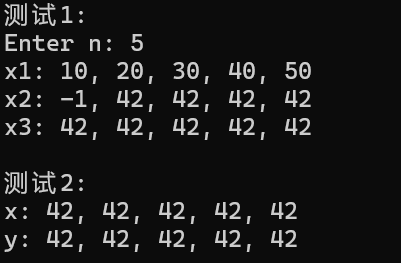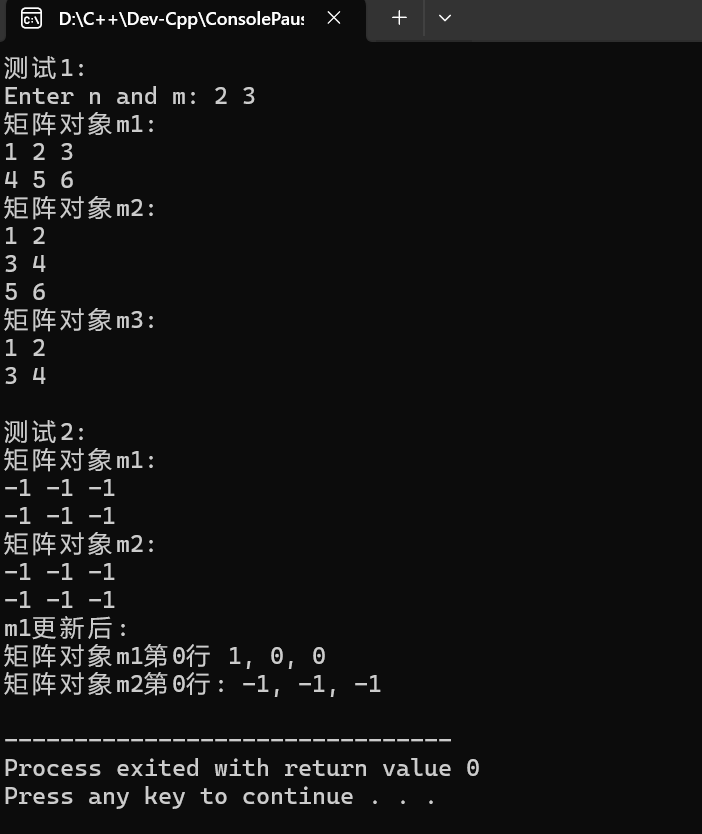实验3
##实验任务1
#代码
1 #pragma once 2 3 #include <iostream> 4 #include <string> 5 6 class Button 7 { 8 public: 9 Button(const std::string& label_); 10 const std::string& get_lab() const; 11 void click(); 12 13 private: 14 std::string label; 15 }; 16 17 inline const std::string& Button::get_lab() const { 18 return label; 19 } 20 21 inline void Button::click() { 22 std::cout << "Button '" << label << "' clicked\n"; 23 } 24
1 #pragma once 2 3 #include <iostream> 4 #include <vector> 5 #include <algorithm> 6 #include <string> 7 8 #include "Button.h" 9 10 class Window 11 { 12 public: 13 Window(const std::string& title_); 14 15 void display() const; 16 void close(); 17 void add_button(const std::string& label); 18 void click_button(const std::string& label); 19 20 private: 21 bool has_button(const std::string& label) const; 22 23 private: 24 std::string title; 25 std::vector<Button> buttons; 26 }; 27 28 inline void Window::display()const { 29 std::string s(40, '*'); 30 std::cout << s << std::endl; 31 std::cout << "window : " << title << std::endl; 32 int cnt = 0; 33 for (const auto& button : buttons) 34 std::cout << ++cnt << ". " << button.get_lab() << std::endl; 35 std::cout << s << std::endl; 36 } 37 38 inline void Window::close() { 39 std::cout << "close window '" << title << "'" << std::endl; 40 click_button("close"); 41 } 42 43 inline bool Window::has_button(const std::string& label) const { 44 for (const auto& button : buttons) 45 if (button.get_lab() == label) 46 return true; 47 48 return false; 49 } 50 51 inline void Window::add_button(const std::string& label) { 52 if (has_button(label)) 53 std::cout << "button " << label << " already exists!\n"; 54 else 55 buttons.push_back(Button(label)); 56 } 57 58 inline void Window::click_button(const std::string& label) { 59 for (auto& button : buttons) 60 if (button.get_lab() == label) { 61 button.click(); 62 return; 63 } 64 std::cout << "no button: " << label << std::endl; 65 }
1 #include "Window.h" 2 #include <iostream> 3 4 void test() { 5 Window w("Demo"); 6 w.add_button("add"); 7 w.add_button("remove"); 8 w.add_button("modify"); 9 w.add_button("add"); 10 w.display(); 11 w.close(); 12 } 13 14 int main() { 15 std::cout << "用组合类模拟简单GUI:\n"; 16 test(); 17 }
#运行结果

##问题
1.是,Window类包含Button对象作为成员。
2.(1)优点:外部可以查询窗口是否包含特定按钮;风险:破坏了封装性,存在误用风险。
(2)用户需求:用户是否需要直接调用这个功能;
封装性:是否是内部实现细节;状态安全:是否会破坏对象的不变性或内部状态。
3.接口1返回引用,避免字符串拷贝,性能更好;
接口2返回的是副本,生命周期独立,更安全。
4.正常运行,push_back(Button(label)),创建临时对象,就并且调用结束后临时对象被销毁;emplace_back(label),直接在vector的内存空间中构造Button对象,避免临时对象的创建和销毁。
##实验任务2
#代码
1 #include <iostream> 2 #include <vector> 3 4 void test1(); 5 void test2(); 6 void output1(const std::vector<int>& v); 7 void output2(const std::vector<int>& v); 8 void output3(const std::vector<std::vector<int>>& v); 9 10 int main() { 11 std::cout << "深复制验证1:标准库vector<int>\n"; 12 test1(); 13 14 std::cout << "\n深复制验证2:标准库vector<int>嵌套使用\n"; 15 test2(); 16 } 17 18 //验证vector<int>的深复制 19 //拷贝后未修改原容器,仅展示拷贝结果 20 void test1() { 21 std::vector<int> v1(5, 42); //v1:42,42,42,42,42 22 const std::vector<int> v2(v1); 23 24 std::cout << "**********拷贝构造后**********\n"; 25 std::cout << "v1: "; 26 output1(v1); 27 std::cout << "v2: "; 28 output1(v2); 29 } 30 31 //验证vector<vector<int>>的深复制 32 //拷贝后修改原容器的子vector,观察拷贝容器是否受影响 33 void test2() { 34 std::vector<std::vector<int>> v1{ {1,2,3},{4,5,6,7} }; 35 const std::vector<std::vector<int>> v2(v1); 36 37 std::cout << "**********拷贝构造后**********\n"; 38 std::cout << "v1: "; 39 output3(v1); 40 std::cout << "v2: "; 41 output3(v2); 42 43 v1.at(0).push_back(-1); 44 45 std::cout << "**********修改v1[0]后**********\n"; 46 std::cout << "v1: \n"; 47 output3(v1); 48 std::cout << "v2: \n"; 49 output3(v2); 50 } 51 52 // 使用xx.at()+循环输出vector<int>数据项 53 //v.at(i)—— 安全的元素访问方式(越界时会抛出out_of_range异常,比v[i]更安全) 54 void output1(const std::vector<int>& v) { 55 if (v.size() == 0) { 56 std::cout << '\n'; 57 return; 58 } 59 60 std::cout << v.at(0); 61 for (auto i = 1; i < v.size(); ++i) 62 std::cout << ", " << v.at(i); 63 std::cout << '\n'; 64 } 65 66 // 使用迭代器+循环输出vector<int>数据项 67 void output2(const std::vector<int>& v) { 68 if (v.size() == 0) { 69 std::cout << '\n'; 70 return; 71 } 72 73 //*it:解引用迭代器,获取它指向的元素值 74 auto it = v.begin(); 75 std::cout << *it; 76 77 for (it = v.begin() + 1; it != v.end(); ++it) 78 std::cout << ", " << *it; 79 std::cout << '\n'; 80 } 81 82 // 使用auto for分行输出vector<vector<int>>数据项 83 // 参数类型vector<vector<int>>:二维容器(容器的每个元素也是一个vector<int>) 84 void output3(const std::vector<std::vector<int>>& v) { 85 if (v.size() == 0) { 86 std::cout << '\n'; 87 return; 88 } 89 // 范围 for 循环for (auto& i : v):遍历二维容器的每个元素(即每个子vector<int>) 90 // 用auto&而非auto:避免拷贝子vector,提高效率(auto会触发子容器的拷贝构造,没必要) 91 for (auto& i : v) 92 output2(i); 93 }
#运行结果

##问题
1.构造函数和拷贝构造函数; v1和v2各包含5个42。
2.2 2 3
3.可以 v1.at(0) = -1使用时更加安全;v1[0] = -1使用时存在安全风险,但是性能更好。
4.能输出 调用size()来方法返回对象长度的int值,可以输出-1
优势:避免不必要的拷贝构造,节省内存 限制:不能通过const引用修改所引用的对象,只能进行只读操作
5.(1)深复制(2)当 v 是 vector<int> 时, v.at(0) 返回值类型是int &;当 v 是 const vector<int> 时, v.at(0) 返回值类型是const int &; 是。
##实验任务3
#代码
1 #pragma once 2 3 #include <iostream> 4 5 //动态int数组对象 6 class VectorInt 7 { 8 public: 9 VectorInt(); 10 VectorInt(int n_); 11 VectorInt(int n, int value); 12 VectorInt(const VectorInt& vi); 13 ~VectorInt(); 14 15 int size() const; 16 int& at(int index); 17 const int& at(int index) const; 18 VectorInt& assign(const VectorInt& vi); 19 20 int* begin(); 21 int* end(); 22 const int* begin() const; 23 const int* end() const; 24 25 private: 26 int n; //当前数据项个数 27 int* ptr; //数据区 28 }; 29 30
1 #include "VectorInt.h" 2 3 VectorInt::VectorInt() :n{ 0 },ptr{ nullptr } { 4 } 5 6 VectorInt::VectorInt(int n_) :n{ n_ }, ptr{ new int[n] } { 7 } 8 9 VectorInt::VectorInt(int n_, int value) :n{ n_ }, ptr{ new int[n_] } { 10 for (auto i = 0; i < n; i++) 11 ptr[i] = value; 12 } 13 14 VectorInt::VectorInt(const VectorInt& vi) :n{ vi.n }, ptr{ new int[n] } { 15 for (auto i = 0; i < n; ++i) 16 ptr[i] = vi.ptr[i]; 17 } 18 19 VectorInt::~VectorInt() { 20 delete[] ptr; 21 } 22 23 int VectorInt::size() const { 24 return n; 25 } 26 27 const int& VectorInt::at(int index) const { 28 if (index < 0 || index >= n) { 29 std::cerr << "IndexError: index out of range\n"; 30 std::exit(1); 31 } 32 return ptr[index]; 33 } 34 35 int& VectorInt::at(int index) { 36 if (index < 0 || index >= n) { 37 std::cerr << "IndexError: index out of range\n"; 38 std::exit(1); 39 } 40 return ptr[index]; 41 } 42 43 VectorInt& VectorInt::assign(const VectorInt& vi) { 44 if (this == &vi) 45 return *this; 46 int* ptr_tmp; 47 ptr_tmp = new int[vi.n]; 48 for (int i = 0; i < vi.n; ++i) 49 ptr_tmp[i] = vi.ptr[i]; 50 delete[] ptr; 51 n = vi.n; 52 ptr = ptr_tmp; 53 return *this; 54 } 55 56 int* VectorInt::begin() { 57 return ptr; 58 } 59 60 int* VectorInt::end() { 61 return ptr + n; 62 } 63 64 const int* VectorInt::begin() const { 65 return ptr; 66 } 67 68 const int* VectorInt::end() const { 69 return ptr + n; 70 } 71 72
1 #include "VectorInt.h" 2 3 #include <iostream> 4 5 void test1(); 6 void test2(); 7 void output1(const VectorInt& vi); 8 void output2(const VectorInt& vi); 9 10 int main() { 11 std::cout << "测试1: \n"; 12 test1(); 13 std::cout << "\n测试2: \n"; 14 test2(); 15 } 16 17 void test1() { 18 int n; 19 std::cout << "Enter n: "; 20 std::cin >> n; 21 VectorInt x1(n); 22 for (auto i = 0; i < n; ++i) 23 x1.at(i) = (i + 1) * 10; 24 std::cout << "x1: "; output1(x1); 25 VectorInt x2(n, 42); 26 VectorInt x3(x2); 27 x2.at(0) = -1; 28 std::cout << "x2: "; output1(x2); 29 std::cout << "x3: "; output1(x3); 30 } 31 32 void test2() { 33 const VectorInt x(5, 42); 34 VectorInt y; 35 y.assign(x); 36 std::cout << "x: "; output2(x); 37 std::cout << "y: "; output2(y); 38 } 39 40 // 使用xx.at()+循环输出VectorInt对象数据项 41 void output1(const VectorInt& vi) { 42 if (vi.size() == 0) { 43 std::cout << '\n'; 44 return; 45 } 46 std::cout << vi.at(0); 47 for (auto i = 1; i < vi.size(); ++i) 48 std::cout << ", " << vi.at(i); 49 std::cout << '\n'; 50 } 51 52 // 使用迭代器+循环输出VectorInt对象数据项 53 void output2(const VectorInt& vi) { 54 if (vi.size() == 0) { 55 std::cout << '\n'; 56 return; 57 } 58 auto it = vi.begin(); 59 std::cout << *it; 60 for (it = vi.begin() + 1; it != vi.end(); ++it) 61 std::cout << ", " << *it; 62 std::cout << '\n'; 63 } 64
##运行结果

##问题
1.版本2缺少自赋值检查
2.(1)类型转换
转换前:vectorInt*(非const指针)
转换后:const vectorInt*(const指针)
将当前对象转换为const版本,以便调用const版本的at()方法
(2)const_cast<int&>作用是移除const修饰符,使返回值可以用于修改操作 转换前this返回类型是const int& 转换后返回类型是int& 目的:满足非const接口的返回类型要求
3.(1)非const版本:用于需要修改容器内容的场景 const版本:用于只读访问或const对象的场景
(2)vectorInt直接返回原始指针作为迭代器,说明迭代器本质上是提供统一访问接口的抽象
4.可以,fill将ptr开始的n个元素都设置为value copy 从vi.ptr复制n个元素到ptr
##实验任务4
#代码
1 #pragma once 2 3 class Matrix { 4 public: 5 Matrix(int rows_, int cols_, double value = 0); 6 Matrix(int rows_, double value = 0); 7 Matrix(const Matrix &x); 8 ~Matrix(); 9 10 void set(const double *pvalue, int size); 11 void clear(); 12 const double& at(int i, int j) const; 13 double& at(int i, int j); 14 int rows() const; 15 int cols() const; 16 void print() const; 17 18 private: 19 int n_rows; 20 int n_cols; 21 double *ptr; 22 };
1 #include "matrix.hpp" 2 #include <iostream> 3 #include <cstdlib> 4 #include <algorithm> 5 6 // 构造函数:rows_×cols_矩阵 7 Matrix::Matrix(int rows_, int cols_, double value) 8 : n_rows(rows_), n_cols(cols_), ptr(new double[rows_ * cols_]) { 9 if (rows_ <= 0 || cols_ <= 0) { 10 std::cerr << "Error: Invalid matrix dimensions\n"; 11 std::exit(1); 12 } 13 std::fill_n(ptr, n_rows * n_cols, value); 14 } 15 16 // 构造函数:rows_×rows_方阵 17 Matrix::Matrix(int rows_, double value) 18 : n_rows(rows_), n_cols(rows_), ptr(new double[rows_ * rows_]) { 19 if (rows_ <= 0) { 20 std::cerr << "Error: Invalid matrix dimensions\n"; 21 std::exit(1); 22 } 23 std::fill_n(ptr, n_rows * n_cols, value); 24 } 25 26 // 拷贝构造函数(深拷贝) 27 Matrix::Matrix(const Matrix &x) 28 : n_rows(x.n_rows), n_cols(x.n_cols), ptr(new double[x.n_rows * x.n_cols]) { 29 std::copy(x.ptr, x.ptr + n_rows * n_cols, ptr); 30 } 31 32 // 析构函数 33 Matrix::~Matrix() { 34 delete[] ptr; 35 } 36 37 // 设置矩阵数据 38 void Matrix::set(const double *pvalue, int size) { 39 if (size != n_rows * n_cols) { 40 std::cerr << "Error: Size mismatch in set()\n"; 41 std::exit(1); 42 } 43 std::copy(pvalue, pvalue + size, ptr); 44 } 45 46 // 清空矩阵(置0) 47 void Matrix::clear() { 48 std::fill_n(ptr, n_rows * n_cols, 0.0); 49 } 50 51 // 常量版本的元素访问 52 const double& Matrix::at(int i, int j) const { 53 if (i < 0 || i >= n_rows || j < 0 || j >= n_cols) { 54 std::cerr << "Error: Index out of range in at()\n"; 55 std::exit(1); 56 } 57 return ptr[i * n_cols + j]; 58 } 59 60 // 非常量版本的元素访问 61 double& Matrix::at(int i, int j) { 62 if (i < 0 || i >= n_rows || j < 0 || j >= n_cols) { 63 std::cerr << "Error: Index out of range in at()\n"; 64 std::exit(1); 65 } 66 return ptr[i * n_cols + j]; 67 } 68 69 // 返回行数 70 int Matrix::rows() const { 71 return n_rows; 72 } 73 74 // 返回列数 75 int Matrix::cols() const { 76 return n_cols; 77 } 78 79 // 打印矩阵 80 void Matrix::print() const { 81 for (int i = 0; i < n_rows; ++i) { 82 for (int j = 0; j < n_cols; ++j) { 83 std::cout << at(i, j) << " "; 84 } 85 std::cout << "\n"; 86 } 87 }
1 #include <iostream> 2 #include <cstdlib> 3 4 #include "Matrix.h" 5 6 void test1(); 7 void test2(); 8 void output(const Matrix& m, int row_index); 9 10 int main() { 11 std::cout << "测试1: \n"; 12 test1(); 13 std::cout << "\n测试2: \n"; 14 test2(); 15 } 16 17 void test1() { 18 double x[1000] = { 1, 2, 3, 4, 5, 6, 7, 8, 9, 10 }; 19 int n, m; 20 std::cout << "Enter n and m: "; 21 std::cin >> n >> m; 22 23 Matrix m1(n, m); // 创建矩阵对象m1, 大小n×m 24 m1.set(x, n * m); // 用一维数组x的值按行为矩阵m1赋值 25 26 Matrix m2(m, n); // 创建矩阵对象m2, 大小m×n 27 m2.set(x, m * n); // 用一维数组x的值按行为矩阵m1赋值 28 29 Matrix m3(n); // 创建一个n×n方阵对象 30 m3.set(x, n * n); // 用一维数组x的值按行为矩阵m3赋值 31 32 std::cout << "矩阵对象m1: \n"; m1.print(); 33 std::cout << "矩阵对象m2: \n"; m2.print(); 34 std::cout << "矩阵对象m3: \n"; m3.print(); 35 } 36 37 void test2() { 38 Matrix m1(2, 3, -1); 39 const Matrix m2(m1); 40 std::cout << "矩阵对象m1: \n"; m1.print(); 41 std::cout << "矩阵对象m2: \n"; m2.print(); 42 m1.clear(); 43 m1.at(0, 0) = 1; 44 std::cout << "m1更新后: \n"; 45 std::cout << "矩阵对象m1第0行 "; output(m1, 0); 46 std::cout << "矩阵对象m2第0行: "; output(m2, 0); 47 } 48 49 // 输出矩阵对象row_index行所有元素 50 void output(const Matrix& m, int row_index) { 51 if (row_index < 0 || row_index > m.rows()) { 52 std::cerr << "IndexError: row index out of range\n"; 53 std::exit(1); 54 } 55 std::cout << m.at(row_index, 0); 56 for (int j = 1; j < m.cols(); ++j) 57 std::cout << ", " << m.at(row_index, j); 58 std::cout << '\n'; 59 }
##运行结果

##实验任务5
#代码
1 #pragma once 2 3 #include <iostream> 4 #include <string> 5 6 // 联系人类 7 class Contact { 8 public: 9 Contact(const std::string &name_, const std::string &phone_); 10 11 const std::string &get_name() const; 12 const std::string &get_phone() const; 13 void display() const; 14 15 private: 16 std::string name; // 必填项 17 std::string phone; // 必填项 18 }; 19 20 Contact::Contact(const std::string &name_, const std::string &phone_) 21 : name{name_}, phone{phone_} { 22 } 23 24 const std::string& Contact::get_name() const { 25 return name; 26 } 27 28 const std::string& Contact::get_phone() const { 29 return phone; 30 } 31 32 void Contact::display() const { 33 std::cout << name << ", " << phone; 34 }
1 # pragma once 2 #include <iostream> 3 #include <string> 4 #include <vector> 5 #include <algorithm> 6 #include "contact.hpp" 7 // 通讯录类 8 class ContactBook { 9 public: 10 void add(const std::string &name, const std::string &phone); // 添加联系人 11 void remove(const std::string &name); // 移除联系人 12 void find(const std::string &name) const; // 查找联系人 13 void display() const; // 显示所有联系人 14 size_t size() const; 15 private: 16 int index(const std::string &name) const; // 返回联系人在contacts内索引,如不存在,返 17 回-1 18 void sort(); // 按姓名字典序升序排序通讯录 19 private: 20 std::vector<Contact> contacts; 21 }; 22 } 23 void ContactBook::add(const std::string &name, const std::string &phone) { 24 if(index(name) == -1) { 25 contacts.push_back(Contact(name, phone)); 26 std::cout << name << " add successfully.\n"; 27 sort(); 28 return; 29 } 30 std::cout << name << " already exists. fail to add!\n"; 31 void ContactBook::remove(const std::string &name) { 32 int i = index(name); 33 if(i == -1) { 34 std::cout << name << " not found, fail to remove!\n"; 35 return; 36 } 37 contacts.erase(contacts.begin()+i); 38 std::cout << name << " remove successfully.\n"; 39 } 40 task5.cpp 41 void ContactBook::find(const std::string &name) const { 42 int i = index(name); 43 if(i == -1) { 44 std::cout << name << " not found!\n"; 45 return; 46 } 47 contacts[i].display(); 48 std::cout << '\n'; 49 } 50 void ContactBook::display() const { 51 for(auto &c: contacts) { 52 c.display(); 53 std::cout << '\n'; 54 } 55 } 56 size_t ContactBook::size() const { 57 return contacts.size(); 58 } 59 int ContactBook::index(const std::string &name) const { 60 for (size_t i = 0; i < contacts.size(); ++i) { 61 if (contacts[i].get_name() == name) { 62 return static_cast<int>(i); 63 } 64 } 65 return -1; 66 } 67 void ContactBook::sort() { 68 std::sort(contacts.begin(), contacts.end(), 69 [](const Contact &a, const Contact &b) { 70 return a.get_name() < b.get_name(); 71 }); 72 }
1 #include "contactBook.hpp" 2 3 void test() { 4 ContactBook contactbook; 5 6 std::cout << "1. add contacts\n"; 7 contactbook.add("Bob", "18199357253"); 8 contactbook.add("Alice", "17300886371"); 9 contactbook.add("Linda", "18184538072"); 10 contactbook.add("Alice", "17300886371"); 11 12 std::cout << "\n2. display contacts\n"; 13 std::cout << "There are "<< contactbook.size() << " contacts.\n"; 14 contactbook.display(); 15 16 std::cout << "\n3. find contacts\n"; 17 contactbook.find("Bob"); 18 contactbook.find("David"); 19 20 std::cout << "\n4. remove contact\n"; 21 contactbook.remove("Bob"); 22 contactbook.remove("David"); 23 } 24 25 int main() { 26 test(); 27 return 0; 28 }
##运行结果






 浙公网安备 33010602011771号
浙公网安备 33010602011771号